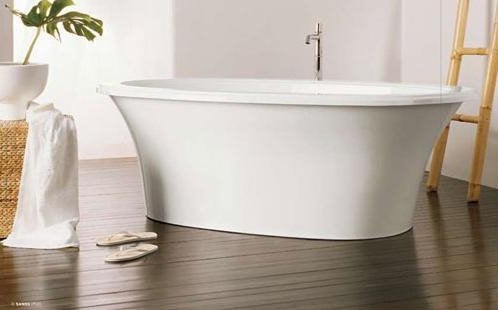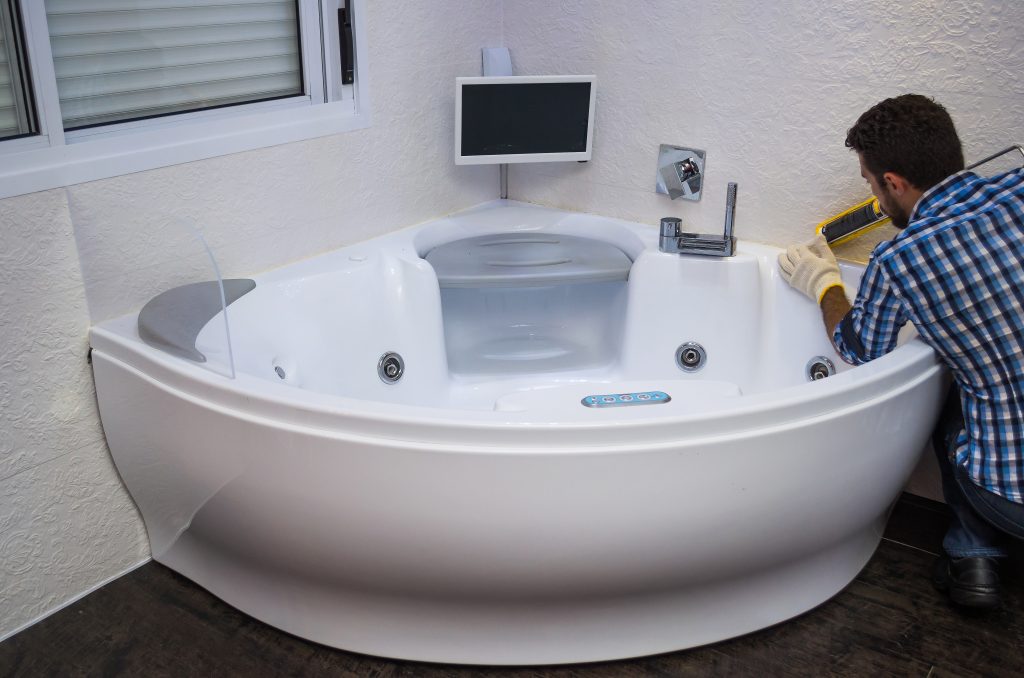Discovering Essential Plumbing Skills is Essential For Installing a Bathtub
Discovering Essential Plumbing Skills is Essential For Installing a Bathtub
Blog Article
Right here below you will discover a bunch of dependable answers pertaining to How to Install a Bathtub: Install an Acrylic Tub and Tub Surround.

Installing a tub isn't specifically rocket science, however it does need solid plumbing, carpentry, and in some cases, tiling abilities. Replacing an old bathtub with a new one is likewise a moderately challenging job. If the old tub is readily available, the project can relocate quickly; if you have to open up a wall to get rid of the old tub and also position the new tub, the job is a lot harder. In either instance, the job is within a home handyman's skills, although you will certainly need an assistant to leave the old tub and set in the new one. See to it you have actually qualified on your own for the task and also are comfortable attempting it. Instead of hiring a contractor to take control of a halfway-completed project, it is far better to think about utilizing one before you begin. Possibilities are you may need an expert plumber to make tube connections.
This write-up will certainly aid you install a brand-new tub in your washroom if you have actually currently acquired a new bathtub and also do not need to change the setup of your previous water system pipelines.
Your devices and also product list must comprise the following:
Removing Old Touches
If you require to replace old taps with brand-new ones as a part of your installment, then the first thing you should do is separate the water. After doing so, activate the faucets to drain any water remaining in the system. The process of getting rid of the existing faucets can be rather bothersome as a result of the restricted accessibility that is frequently the situation.
Use a container wrench (crowsfoot spanner) or a faucet device to reverse the nut that attaches the supply pipes to the faucets. Have a cloth ready for the continuing to be water that will originate from the pipes. When the supply pipelines have been gotten rid of, utilize the very same device to loosen up the nut that holds the faucets onto the bath/basin. You will need to quit the single taps from turning during this process. Once the faucets have actually been removed, the holes in the bath/basin will need to be cleansed of any kind of old securing substance.
Prior to proceeding to fit the new taps, compare the pipeline connections on the old taps to the brand-new taps. If the old taps are longer than the brand-new faucets, then a shank adapter is required for the new taps to fit.
Suitable New Taps
If the tails of the brand-new faucets are plastic, after that you will certainly require a plastic adapter to stop damage to the thread. One end of the adapter fits on the plastic tail of the tap as well as the various other end supplies a link to the existing supply pipelines.
If you need to fit a monobloc, after that you will certainly call for minimizing couplers, which attaches the 10mm pipe of the monobloc to the conventional 15mm supply pipe.
Next off, place the tap in the placing opening in the bath/basin guaranteeing that the washing machines remain in location in between the tap and the sink. Secure the tap in place with the supplier given backnut. Once the tap is securely in position, the supply pipelines can be connected to the tails of the faucets. The taps can either be attached by utilizing corrugated copper piping or with typical tap connectors. The former type ought to be connected to the tap ends initially, tightening up just by hand. The supply pipes can later on be connected to the various other end. Tighten both ends with a spanner after both ends have actually been connected.
Mounting the Bathtub
Making use of both wooden boards under its feet, put the tub in the required position. The wooden boards are handy in evenly spreading the weight of the bath tub over the location of the boards rather than focusing all the weight onto 4 little points.
The next goal is to make certain that the bath tub is leveled all round. This can be achieved by inspecting the level as well as readjusting the feet on the bath tub till the level reads level.
To mount taps, fit the bottom of the outermost flexible tap connector to the proper supply pipe by making a compression join; then do the exact same for the other faucet.
Turn on the water supply and inspect all joints and new pipework for leaks and also tighten them if essential. Fill up the bath tub and likewise check the overflow outlet and the regular outlet for leaks.
Ultimately, repair the bath paneling as defined in the producer's user's manual. Tiling as well as sealing around the bath tub should wait up until the bath tub has actually been made use of at the very least once as this will settle it into its last setting.
Preparing for the Installation
Firstly, the supporting frame supplied with the bathroom needs to be fitted (if called for) according to the manufacturer's directions. Next off, fit the faucets or mixer to the bath tub. When suitable the faucet block, it is necessary to make certain that if the faucet comes with a plastic washing machine, it is fitted in between the bath as well as the taps. On a plastic bath, it is also reasonable to fit a sustaining plate under the taps system to stop strain on the tub.
Fit the versatile faucet connectors to the bottom of both faucets utilizing 2 nuts and olives (occasionally supplied with the tub). Fit the plug-hole outlet by smearing mastic filler round the sink electrical outlet hole, and then pass the outlet via the hole in the bathroom. Utilize the nut provided by the supplier to fit the plug-hole. Examine the plug-hole electrical outlet for an inlet on the side for the overflow pipe.
Next, fit the end of the flexible overflow pipe to the overflow electrical outlet. After that, screw the pipe to the overflow face which must be fitted inside the bathroom. Make certain you make use of all of the supplied washing machines.
Connect the trap to the bottom of the waste outlet on the bathtub by winding the thread of the waste electrical outlet with silicone mastic or PTFE tape, and screw on the catch to the outlet. Connect all-time low of the overflow tube in a comparable manner.The bath should currently be ready to be fitted in its final setting.
Tiling Around the Bathtub
In the location where the bathroom satisfies the ceramic tile, it is essential to seal the joins with a silicone rubber caulking. This is important as the fitting can move enough to break a stiff seal, causing the water to pass through the wall between the bathroom and the tiling, leading to complications with dampness and also feasible leaks to the ceiling below.
You can choose from a range of coloured sealers to assimilate your components and fittings. They are offered in tubes and also cartridges, as well as can securing gaps up to a width of 3mm (1/8 inch). If you have a bigger space to fill up, you can load it with spins of drenched paper or soft rope. Remember to always fill the tub with water prior to sealing, to allow for the activity experienced when the tub remains in usage. The sealer can fracture rather early if you do not consider this movement before securing.
Conversely, ceramic coving or quadrant tiles can be utilized to edge the bathroom or shower tray. Plastic strips of coving, which are easy to use as well as reduce to dimension, are also quickly available on the marketplace. It is suggested to fit the floor tiles utilizing waterproof or water resistant glue and grout.
Bathtub Installation
How Important Is A Bathtub To Your Home?
High-quality baths, showers, and other bathroom updates are necessary when considering a smart investment in your home. It’s a room that you go to every day and one that is constantly being used by guests.The bathroom is one of the top trafficked rooms in a home and also one of the most valuable in terms of home resale.
Install Piping Before Tub
You will be using your existing drain and waste vent system, but pipes required include the hot and cold water supply lines and a pipe leading to a shower head. A mixing valve and shower head are also needed. Air chambers may be required.
Position the Tub
Lower the tub into place so that the continuous flange fits against the wall studs and rests on 1’x4' or 2’x4' supports. Anchor the tub to the enclosure with nails or screws inserted through the flanges into the studs.
NOTE: Remember, bathtubs and shower stalls may require support framing. A bathtub filled with water is extremely heavy, so check building codes and framing support before installing the tub.
Assemble Drain Connections
Assemble the bathtub drain connections by connecting the tub overflow with the tub drain above the trap, not beyond it. The trap will have a compression fitting that screws over the arm of the overflow assembly.
Place a Pipe For the Shower Head
First, locate a brass female threaded winged fitting and attach it to a framing support via a screw or a nail. Then run a pipe up the wall for the shower head. Sweat or solder the other side of the brass fitting to the top of the pipe.
Attaching Hot and Cold Water Lines
Attach your water lines for both hot and cold by sweating these directly into the hot and cold ports of the mixing valve. The mixing valve will be how water enters the tub’s system, not by the pipes themselves.
Install the Spout
Extend a piece of 1/2 inch pipe, or whichever length is specified in the manufacturer’s instructions, for the tub spout. Sweat on a male threaded fitting at the end of the pipe or use a brass nipple of the proper length and a 1/2 inch cap.
NOTE: At this point you should have your rough-in plumbing work inspected before proceeding further.
Check For Leaks
Restore the water pressure and check the drain connection and the supply pipes for any sign of leaking.
estore the Bathroom Wall
Replace the wall with moisture-resistant drywall as a base for your wall covering. Seal the joints between the wall and your new tub with silicone caulk as protection against water seepage.
https://www.berkeys.com/2016/12/02/bathtub-installation-dallas/

I found that review on Tools You Need to Install a New Bathtub while scouting around the internet. Sharing is caring. Helping people is fun. I recognize the value of reading our article about Installing A Bathtub.
Schedule Services Report this page